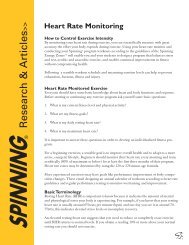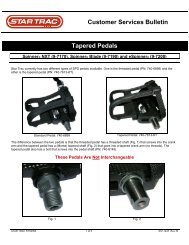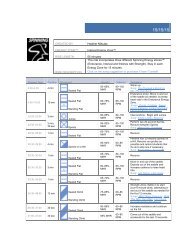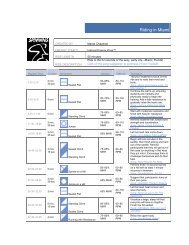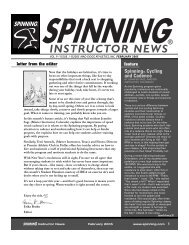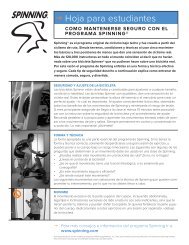bike maintenance.qxd - Spinning
bike maintenance.qxd - Spinning
bike maintenance.qxd - Spinning
You also want an ePaper? Increase the reach of your titles
YUMPU automatically turns print PDFs into web optimized ePapers that Google loves.
Research & Articles>><br />
Bike Maintenance<br />
by Jeff Wimmer<br />
Now is the time to get your <strong>bike</strong>s tuned up and dialed in. Facilities that use a proactive,<br />
preventive <strong>maintenance</strong> program will incur less downtime and less need for parts<br />
replacement. Check out these helpful tips to get started:<br />
Detailing<br />
One of the most important and often<br />
overlooked aspects of a good <strong>maintenance</strong><br />
program is detailing. Although it’s always<br />
helpful when students wipe down <strong>bike</strong>s after<br />
class, this can’t be your only approach to<br />
keeping <strong>bike</strong>s clean.<br />
A facility with an active <strong>Spinning</strong>® program<br />
should ensure <strong>bike</strong>s are wiped down every day<br />
and cleaned thoroughly at least twice a week.<br />
With an absorbent cloth, focus on wiping<br />
painted and hardware areas and anyplace perspiration has settled. Dabbing <strong>bike</strong> polish on<br />
painted areas can also facilitate this process. Make sure you occasionally detail <strong>bike</strong>s upside<br />
down to prevent rusting and corrosion. And don’t forget: When starting a procedure on a<br />
group of <strong>bike</strong>s, don’t stop that procedure until it is completed on each one. Your members<br />
will feel fantastic about getting on a clean, shiny Spinner!<br />
Handlebar and Seat Adjustments<br />
Before any <strong>Spinning</strong> class, the first thing members usually do is adjust the seat and<br />
handlebars. Therefore, you’ll want to keep the inside frames of handlebars and seats<br />
lubricated for ease of adjustment. To wipe down these parts, use a spray bottle with a<br />
disinfectant and clean rag. And don’t skip the handlebar wipe down—handlebars are most<br />
notorious for rusting. Be sure to keep this area cleaned and lubed.<br />
Water Bottle Holders<br />
When a member gets on a <strong>bike</strong>, eager for class to start and finds a broken water bottle cage<br />
it’s frustrating. If it’s corroded and unsanitary it’s even worse. Because this area is inundated<br />
with sweat and water, the connection point between the bottle cage and frame will<br />
frequently loosen and corrode. Also, if the water bottle cage is loose or rattling, the connector<br />
screws may need tightening.<br />
Saddles<br />
This key component of the <strong>bike</strong> should always be in excellent working order. If a seat is<br />
cracked, broken or just plain uncomfortable, replace it immediately. A $35 part could cost<br />
you a class participant.
Research & Articles>><br />
Pop Pins<br />
Because they cannot be adjusted, broken or unusable pop pins can equal an unusable <strong>bike</strong>.<br />
If necessary, remove corrosion or rust buildup with a small wire brush. After cleaning,<br />
apply a small amount of grease to the threaded area to promote proper mobility.<br />
Following these few <strong>maintenance</strong> checks will keep issues minimal and riders happy. Check<br />
out the new Ultimate Spinner® Bike Tech Manual (available from Mad Dogg Athletics),<br />
which is a comprehensive “how-to” guide on these helpful tips and many more!<br />
<strong>Spinning</strong>® Instructor News,July 2003,Volume 7, Issue 6<br />
For more information,<br />
visit www.spinning.com.



